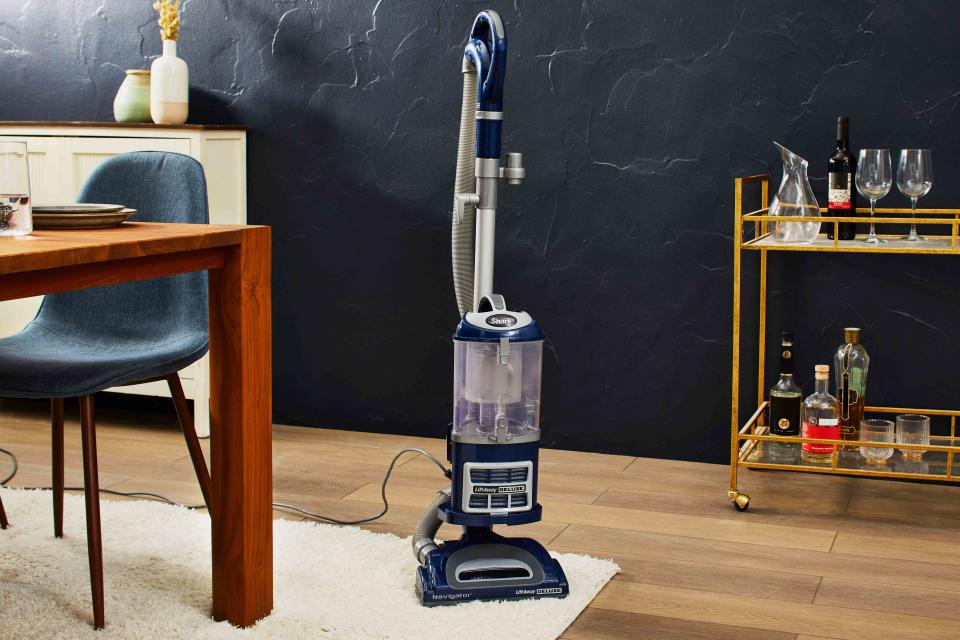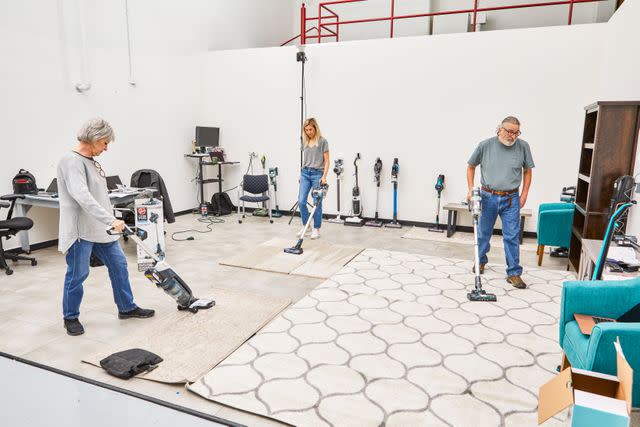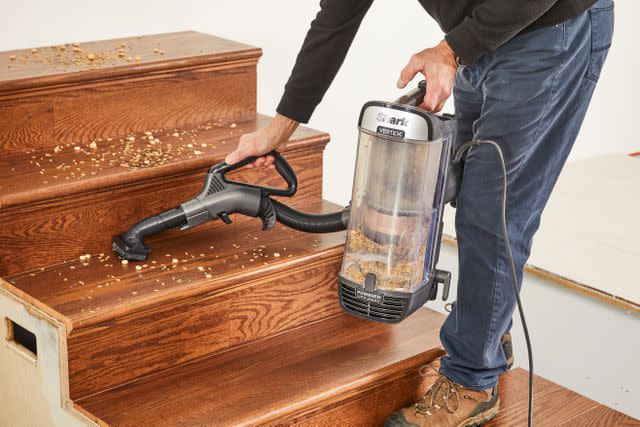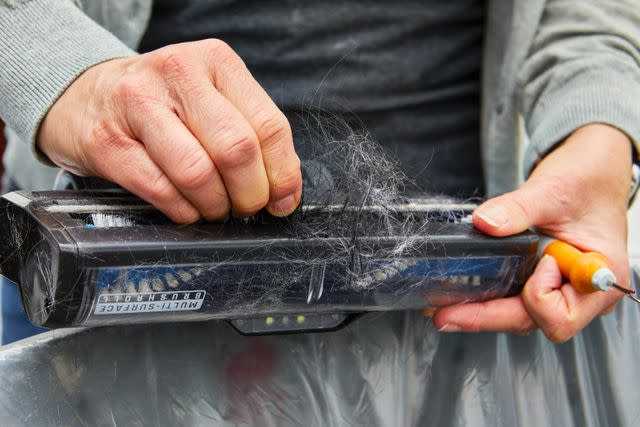The 7 Best Vacuums for Your Kitchen, Dining Room, and Beyond
Dotdash Meredith and Yahoo Inc. may earn commission or revenue on some items through the links below.
Whatever type of floors you have, these top models are the solution to your cleaning conundrums.

Food & Wine / Henry Wortock
Having the right vacuum makes a big difference when cleaning your floors — just like having durable scrubbing tools simplifies the task of dishwashing. If you have a vacuum cleaner that’s clunky and inefficient, it’s easy to put off weekly cleanings when it’s anything but easy or effective. However, with one that’s painless to operate, has strong suction power, and is light enough to carry from room to room, you won’t have to think twice about getting it out to enjoy the sweet relief of spotless floors.
To help you narrow it down, we've tested dozens of highly rated and recommended vacuums, from portable, handheld vacuums and cordless stick vacuums to upright vacuums that double as mops. After months of cleaning spills and debris on all types of floors, we determined the best vacuums to suit every lifestyle and living situation. Read on to find the right picks for you.
Best Overall: Shark NV360 Navigator Lift-Away Deluxe Upright Vacuum

Pros
It’s versatile, highly effective, and easily maneuverable.
Cons
Hair caught in the vacuum while cleaning the carpet can be difficult to remove.
Investing in this high-performing upright vacuum is like getting two appliances for one since it works well as an upright vacuum and can function like a canister vacuum. You can lift away the pod and use it with the hose to clean in more places, such as around door frames, stairs, and upholstery. We were impressed with the vacuum’s strong suction on floors and upholstery and found that the vacuum picked up all of the debris on all surfaces in one minute or less. For every task we tried, this vacuum was easy to maneuver and the price is in the sweet spot amongst our top picks.
One of the only drawbacks we noted was that when vacuuming hair from the carpet, we found that hair could get tangled in the beater bar and was harder to remove by hand. But using a tool for clearing got the job done, and any hair stuck after vacuuming hard surfaces was minimal and easy to remove.
Price at time of publish: $220
Weight: 15.96 pounds
Dust Bin Capacity: 3.4 liters
Attachments: Upholstery tool and crevice tool
Best Value: Hart Pro Bagless Upright Vacuum with HEPA Media Filter

Pros
Offering good performance at a great price, this vacuum is easy to work with and has conveniently placed attachments.
Cons
It’s on the heavy side.
If you’re in the market for a vacuum you can rely on that won’t give you sticker shock, consider this upright model with a 13-foot reach that gave impressive results during testing. We found it transitions well across surfaces, with great suction on carpeting and upholstery. We also like the swiveling vacuum head for maneuvering around chairs and table legs.
It's easy to grab and swap out the vacuum’s attachments, which are stored on the vacuum itself. One drawback with this model is that it's a little heavy, and rolling it back and forth takes a bit more effort — not enough to be a dealbreaker, though. Overall it's very maneuverable, sturdy, and simple to operate.
Price at time of publish: $169
Weight: 16 pounds
Dust Bin Capacity: Not listed
Attachments: Crevice tool and pet upholstery tool
Best Splurge: Dyson Ball Animal 3 Extra

Pros
You get first-rate suction power and don’t have to deal with hair getting tangled up in the roller.
Cons
It can be cumbersome to use when cleaning stairs.
If there’s one brand associated with splurge-worthy vacuums, it’s Dyson. We’re fans of this particular model because of its excellent suction power. This vacuum works well on both hard surfaces and carpet and transitions easily between the two, thanks in part to its range of height settings from no-pile to high-pile. The coffee grounds, cereal, corn kernels, hair, and lint were gone in just a few passes.
Given the heavier weight of this vacuum and the stiffer resistance of its hose, we found that it could be tiring when used on a flight of stairs, so keep that in mind if your home has multiple stories. Anyone with pets or who constantly vacuums up hair will greatly appreciate how swiftly the vacuum removes even the longest and thickest hair, leaving no tangling in the roller. We were thoroughly impressed by how all hair was instantly sucked into the dust cup.
Price at time of publish: $500
Weight: 17.3 pounds
Dust Bin Capacity: 1.89 liters
Attachments: Tangle-free turbine tool, stair tool, combination tool, and pet groom tool
Best for Pet Hair: Bissell CleanView Swivel Rewind Pet Reach Vacuum Cleaner

Pros
In addition to its high suction capability, this easy-to-empty vacuum also has a conveniently extra-long, easy-to-store cord.
Cons
It’s not as great at cleaning debris on hardwood floors.
We love our furry companions, but every pet owner knows the struggle of hair maintenance all over the house. We gave this vacuum a 10/10 for performance on high-pile carpet and grouted floor, noting that it picked up hair and debris quickly and efficiently. While we noticed that the vacuum didn’t shine as well on the hardwood floor, we still liked how well it cleaned up hair on all surfaces during our tests. Once you’re done vacuuming, this model is a cinch to empty with no residual debris after you empty the canister into the trash can.
This vacuum comes with some other particularly user-friendly features. Firstly, the power cord is very long (27 feet to be exact), so you don’t have to switch between outlets as often as you move around the house. We also loved the excellent cord storage: All you have to do is step on or push the cord storage button, which winds the cord inside the vacuum.
Price at time of publish: $175
Weight: 16.5 pounds
Dust Bin Capacity: 0.6 liters
Attachments: Pet TurboEraser tool, 2-in-1 dusting brush, and crevice tool
Best Cordless: Tineco Pure One S11 Smart Stick/Handheld Vacuum

Pros
Offering great value, this vacuum is easy to move around, makes little noise, and comes with lots of helpful attachments.
Cons
It’s not the cheapest.
If you know you want to go cordless with your vacuum, this lightweight model, which comes with two main brushes plus four other attachments, offers a lot to win you over. During our tests, it earned the highest possible scores for effectiveness and maneuverability, with powerful suction and smooth handling.
A great bonus with this vacuum is just how quiet it is. We found we could still easily converse with another person over the sound and that it wouldn’t bother someone in another room or on another floor. It’s in the middle of the pack cost-wise but delivers high value. We felt it was well worth the price and even better than some pricier models we tried.
Price at time of publish: $400
Weight: 5.8 pounds
Dust Bin Capacity: 0.6 liters
Attachments: LED soft-roller power brush, LED multi-tasker power brush, mini power brush, 2-in-1 dusting brush, crevice tool, and pre-filter cleaning tool
Best Robot: eufy RoboVac X8 Hybrid

Pros
This model uses smart technology to adjust its suction power depending on the floor type and enables you to mop hard floors after vacuuming.
Cons
The small dustbin fills up quickly and needs to be emptied frequently.
During our robot vacuum tests, this model earned the top spot because it's easy to use, versatile, and performs well on all floor types. It has a 180-minute runtime for extended cleaning sessions, saves maps from multiple areas of your home, and features double the suction power of its single-turbine model. Thanks to its innovative design, the device knows when it’s moving from carpet to hard floor or vice versa and changes its power accordingly without any adjustment required on your part. And even with 2000 Pa of suction power, we found that it has a low noise volume, meaning you won’t be bothered as it’s moving around the house.
The robot vacuum stands slightly under 4 inches tall, meaning it can slide under most cabinets, beds, and other low pieces of furniture for a more thorough cleaning throughout the house. The dustbin is only 400 milliliters, so you’ll need to empty it more often than other options on our list.
Price at time of publish: $550
Weight: 7.75 pounds
Dust Bin Capacity: 0.4 liters
Attachments: n/a
Best Handheld: Iris USA Cordless Handheld Vacuum

Pros
Great for nooks and crannies, this extremely lightweight vacuum picks up all kinds of debris without a problem.
Cons
It has a small dustbin that requires more frequent emptying.
Small but mighty, this vacuum with impressive suction power won us over for its quick, efficient performance. It picked up all the debris in every test easily, which tends to be a tall order for a handheld vacuum. If you want to get into the nitty-gritty of its usage, this handheld vacuum performed the best when it was at the highest speed since that maximized suction.
This vacuum’s dust bin capacity is just 3.4 ounces, so you may have to empty it as you continue to spot-clean around the house. It’s worth it to take the time to do so because we did notice that the vacuum doesn’t work as well when the bin is full. It's easy to empty, and the capacity is decent enough you wouldn't need to do it too frequently.
Price at time of publish: $90
Weight: 1.1 pounds
Dust Bin Capacity: 0.1 liters
Attachments: Brush and crevice tool, and multi-surface head
Our Favorite
We chose the Shark NV360 Navigator Lift-Away Deluxe Upright Vacuum as our best overall pick because of its multi-functionality, top-rate performance, and overall value when considering its price. For a cordless option, we recommend the Tineco Pure One S11 Tango/Handheld Vacuum Cleaner because of its strong suction power and easy handling.
Our Vacuum Tests
To determine the best vacuums on the market, we tested over 60 top-rated models in our lab at at home. First, we timed how long it took to set up each vacuum and observed how simple the process was overall. Next, we turned the vacuums on and used a decibel meter to measure how loud the appliance was at its highest setting. Then, we assessed how many passes it took to remove specified amounts of popcorn kernels, cereal, and hair on hard floors and carpets. During these tests, we also noted how the vacuum transitioned between surface types and recorded the runtime of cordless models. For all of the vacuums except robot vacuums, we evaluated how well the appliance cleaned hair from upholstery and how easy it was to remove any trapped hair from the brush roll. Afterward, we also checked for how easy or complicated it was to empty the vacuum cleaner. Throughout, we paid attention to performance, maneuverability, and portability.

Food & Wine / Henry Wortock
Factors to Consider
Vacuum Type
Vacuums can be separated into a few main categories based on their design. Each offers its advantages and is useful for specific messes and surfaces.
Upright
An upright vacuum is the standard design you probably think of when you imagine your average household vacuum. It gets its name because it stands upright (so you don’t have to bend over to clean), and you push it in front of you to vacuum. Some are bagless, while others have bags. They’re known for being great at vacuuming large spaces and performing particularly well on carpets, but they’re bulkier and require more space for storage.

Food & Wine / Dera Burreson
Cordless Stick
Cordless stick vacuums are slim and lightweight. These days, you can find many models that match the suction power of traditional vacuums. One of the biggest advantages of cordless stick varieties is that they offer great portability since you don’t have to stay attached to an outlet to use them. The trade-off is that how much you can clean at a time depends on the battery life.
Robot
Resembling plate-sized discs, robot vacuums move about your space without needing any monitoring or handling from you. If you don’t have time to give your floors a daily or weekly cleaning, robot vacuums keep things looking tidier whether or not you’re home. Many robot vacuums can be connected to an app, allowing you to map out exactly where and where not to clean. Some robot vacuums also come with an extra mopping capability.
Canister
Canister vacuums have two main pieces: a body, where the motor is and the debris is kept, and a head, where the debris is sucked up. These two parts are connected by a long, flexible hose that enables you to clean your windows, ceilings, and other harder-to-reach areas. Canister vacuums are powerful but clunkier, especially if the body doesn’t have wheels.
Handheld
Handheld vacuums are small, light, and powered by batteries. They’re not designed to clean all of the floors in your house, but they’re great for tackling small, isolated messes, getting into tight corners and spaces (your car, for example), and using on upholstery. While easy to carry, they’re not the most powerful and need more frequent emptying and charging.
Filter
It’s crucial to get a vacuum with good filtration so that as you clean your floors, you’re not pushing the debris back into the air. Vacuums come with different types of filters, including paper or bag filters that need to be replaced regularly, as well as foam and cyclone filters that can and should be cleaned after a certain period of time. You’ll find that many vacuums nowadays have HEPA filters, which are high-efficiency particulate air filters. A great choice for anyone with allergies, these are good at trapping very small dust particles, dander, pollen, and more.
Floor Type
If you’re investing in a vacuum, be sure it’s suitable for the types of floor in your home. Vacuums with stiff bristles and a bristle/beater bar may be great for deep-cleaning carpet, but you’ll want one with a soft brush, a beater bar you can switch off, or no beater bar at all for wood flooring to prevent scratches. It’s common to find vacuums with different attachments for various floor types because they allow you to use one device in all areas of your home.
Weight
Depending on their type, vacuums can weigh between 2 and 20 pounds. A vacuum’s weight helps you determine how easy it will be to transport the device from place to place. Generally speaking, upright vacuums are on the heavier side, while handheld and cordless stick vacuums tend to be lighter. Canister vacuums are technically heavy, but when using one, the canister that contains the motor stays on the ground while you move the hose around.

Food & Wine / Dera Burreson
Suction Power
Strong suction power is key to a great vacuum. “Online reviews should tell you the aggregate sentiment of a vacuum's suction after using it for a while, and I always use this as a gut check to give me hints on what to investigate,” says Melissa Maker, a cleaning expert and the host of the YouTube channel Clean My Space. “Budget brands lose suction over time and throughout a charge if the vacuum is cordless. Much like a car, it comes down to the motor of the vacuum and how well-designed that is and secondly, how well maintained that is, so ease of maintenance is important for good design.”
Attachments
You can find vacuums with a range of special attachments and features, including tools for cleaning different floor types (for example, carpet versus hard floor), getting into small crevices and corners, dusting, extending the vacuum’s reach, and more. Maker says you should ask yourself whether a vacuum’s tools make sense for your space and your needs, like how a mini motorized head would be ideal if you have carpeted stairs or pets. Sometimes manufacturers sell the same type of vacuum with fewer attachments included for a lower price.
Frequently Asked Questions
What’s the best type of vacuum?
The best type of vacuum for you depends on what kind of home you have and how you like to clean it. For starters, a corded upright or canister vacuum might be the best choice if you have a large house. Not only will you get strong suction power, but your cleaning won’t be interrupted by the battery running out. If you have a smaller space, a cordless stick vacuum gets the job done without taking up much storage room. Although they’re not necessarily the most useful for cleaning all the floors in your house, handheld vacuums are great if you’re doing a lot of targeted cleaning. Many people use robot vacuums for maintenance between deep cleanings with larger vacuums.
When choosing the best vacuum for your house, it’s also critical to get something suitable for your floor types. Some vacuums shine with hardwood floors, while others offer more power to thoroughly clean thick carpets. These days, many vacuums come with different attachments for different types of flooring.
Do cordless vacuums work as well as corded ones?
It’s tricky to give a definitive answer about whether cordless or corded vacuums work better, as both categories have a wide range of quality. In general, though, it depends on what you’re prioritizing during use. Cordless vacuums are more portable, offer extra maneuverability, and can be easier to store in small spaces. Meanwhile, corded vacuums typically deliver more suction power (better for high-pile carpets), often have a higher dust capacity, and eliminate any concerns about the battery running out during longer cleaning jobs. That being said, Maker says, “Cordless vacuums have greatly advanced in their capacity, runtime, and features in my experience.”
How much does a vacuum cost?
Vacuums cost anywhere from $100 up to $1,000 or more. It’s important to remember that a handheld vacuum won’t cost as much as an upright, canister, or cordless stick vacuum but could be a sizable trade-off in terms of usability, runtime, and suction power.
How long can you expect a vacuum cleaner to last?
“A good vacuum should last you 5 to 10 years,” Maker says. In terms of your vacuum cleaner’s longevity, maintenance is crucial. “Vacuums are motorized, and if the motor overheats, like a car, we can run into performance issues. A vacuum overheats when the filter is dirty, and the bin isn't emptied regularly.” She recommends emptying the bin before it hits the max fill line, cleaning your vacuum tools and bin a couple of times each year, and checking the filter. “My vacuums have lasted me several years when maintained this way."
Other Vacuums We Tested
Strong Contenders
Shark NV356E S2 Navigator Lift-Away Professional Upright Vacuum ($200 at Amazon)
This vacuum is very simple to set up and offers a pretty good overall value, but it isn’t the easiest to empty. A lot of hair gets wrapped up in the machinery and requires extra cleaning every time.
Dyson V15 Detect ($750 at Target)
While this Dyson earned high marks for its attractiveness, portability, and maneuverability, it wasn’t enough to justify its high price. Other vacuums offer the same kind of performance at a lower investment.
Miele Complete C3 Marin Canister Vacuum Cleaner ($1,369 at Amazon)
We love how wonderfully quiet and convenient to move around this Miele is, but the price-to-performance ratio feels way off. We have to go over the same spot several times to pick up all the debris.
BLACK+DECKER Powerseries Extreme Cordless Stick Vacuum Cleaner ($174 at Amazon)
This vacuum was effective at picking up all kinds of debris on different surface types, but it’s a bit too challenging to empty. It’s tricky inserting the dust canister back in so that it fits properly.
Roborock S7+ Robot Vacuum and Sonic Mop with Auto-Empty Dock ($950 at Amazon)
While this quiet Roborock did a decent job vacuuming, its mopping capability left much to be desired. If the floor was really messy, you would likely have to mop yourself afterward to clean up all the residue.

Food & Wine / Henry Wortock
What Didn't Make the List
Of the various other vacuums we tested, some models from big names like Kenmore, Eureka, and Black+Decker didn’t make the list because of their low suction performance, which in turn meant they offered little value for their price. In addition to having minimal effectiveness picking up debris, other common issues with the lower-scoring vacuums included being too difficult to maneuver (whether due to their heaviness or clunkiness) and having too high a noise level.
Our Expertise
Cindy Brzostowski is a freelance writer and avid home cook who has previous experience in cookbook publishing (and has left more than her fair share of messes on the kitchen floor while cooking). Her writing has been featured in Allrecipes, Blue Apron, The Kitchn, and EatingWell among other publications. For this article, she used our in-depth, in-house testing insights and spoke to Melissa Maker, a cleaning expert and the host of the YouTube channel Clean My Space.
For more Food & Wine news, make sure to sign up for our newsletter!
Read the original article on Food & Wine.

